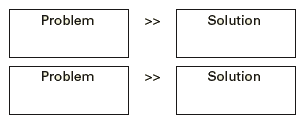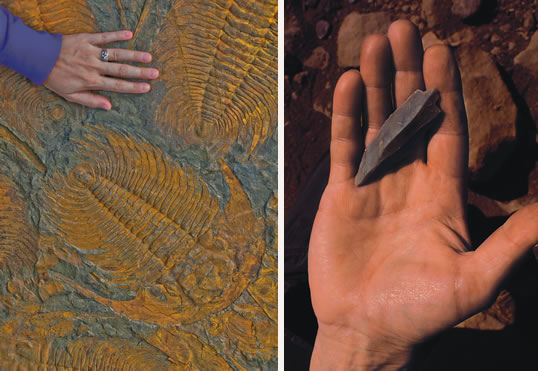
For students: We hope this two-page guide will help sharpen your reading skills and deepen your understanding of this issue’s articles.
For teachers: We encourage reproduction and adaptation of these ideas, freely and without further permission from Saudi Aramco World, by teachers at any level, whether working in a classroom or through home study.
— THE EDITORS
Class Activities
Several articles in this issue touch on the theme of “uncovering,” and so this month’s Classroom Guide is organized around that theme. Three articles look at “uncovering” in a literal sense: How have archeologists gone about uncovering monuments and mosaics, and how have geologists gone about uncovering fossils? Another article looks at how scientists are “uncovering”—in the sense of revealing what was hidden—the Arabian leopard, an animal that has survived by concealing itself from, and eluding contact with, humans. But the articles go to a deeper level, too. In a more figurative sense, one article asks a more profound question: How can we uncover the truth?
Theme: Uncovering
How do people uncover objects that have been buried? How do they uncover (find) animals that don’t want to be found?
Divide the class into three groups. Assign each group one of these articles to read: “Morocco’s Trilobite Economy,” “I, Mosaic Masterpiece” and “The Last Lair of the Leopard.” Assign each group the task of presenting to the rest of the class the content of its article. For now, focus on the act of uncovering. Later you’ll have a chance to think about what becomes of objects once they’re uncovered. Your presentations should include answers to these questions:
- What was concealed?
- Who uncovered it?
- How did they uncover it?
- What challenges did they have to face to do so?
Keep in mind that, in the case of “The Last Lair of the Leopard,” you’ll want to think about “uncovering” as more of a metaphor for finding something that is hard to find rather than literally uncovering something that is covered.
When you’re done reading, answer the four questions with your group. To help you with questions 3 and 4, make a chart to look more closely at how people solve problems. For each problem and solution, make and fill in a graphic that looks like this:

When all the groups have presented, everyone in the class should be able to answer all the questions about all the articles. As a class, discuss any generalizations or conclusions you can draw about solving the problems involved in uncovering what has been hidden.
Why do people go to the trouble of uncovering something when doing so is difficult?
Turn your attention to this last question. As a class, discuss what motivates people to do the kind of work that the trilobite diggers and David Willis (the leopard seeker) have devoted themselves to. Contribute to the discussion based on the article you read. Then think about your own interest—or lack of interest—in what is concealed. Would you be sufficiently interested in any of the “uncoverings” you and your classmates have read about to devote yourself to them the way the people in the articles have? What might be the rewards of doing so? What might be the sacrifices involved?
How can people uncover the truth about what happened in the past?
“The Beginning of the End for Hunter-Gatherers” is also about uncovering. On one level, the uncovering is similar to the situations you read about already: Archeologists are uncovering large monuments. But the uncovering you’re going to look at now is a different kind. It involves uncovering the truth, if it’s possible to know it. Read the article. Notice, as you do, that it might contradict what you expect to find in a magazine article. You probably expect to read something by someone who’s either an expert on a subject, or who has interviewed people who are experts on that subject. You probably expect them to give you some good, hard information. But sometimes there isn’t any good, hard information to give. Or, to be more precise, there may be objects to look at and pieces of data to report—like the age of the soil or the shapes chiseled on a stone. But what do they mean? Often there’s nothing certain about what the evidence tells you. Often the way
to interpret the evidence is up for grabs.
That’s what you’ll find when you read “The Beginning of the End for Hunter-Gatherers.” In the second and third paragraphs, writer Graham Chandler describes a controversy among archeologists. What question does he say the monuments at Göbekli Tepe raise? Write the question at the top of a piece of paper. Then read the article, circling the names of four scholars who offer answers to the question. Write the four names on the piece of paper under the question. Go back through the article with a partner and find how each of the scholars answers the question. Write his answer under each man’s name. Then write, for each, the evidence or information he used to come to that answer.
With your partner, discuss which of the answers you agree with and why. To make your decision, focus on what information the scholars used to reach their conclusions. Is it credible? Is it concrete or speculative? Once you have decided, find another pair who have reached the opposite conclusion and sit down as a group of four. Explain to the other pair how you reached your decision. Listen to them explain how they reached their decision. Do you find the other pair’s argument plausible, even if you don’t agree with it?
Then step back and think about the bigger picture: how scholars gather and interpret data. Have a class discussion that addresses these questions: Why might it matter whether agriculture preceded or followed the building of the monuments at Göbekli Tepe? Why do scholars find it important enough to debate? What do you think it will take for one or the other of the answers to become widely accepted?
Once artifacts are uncovered, what do people do with them?
Having delved into questions of truth, turn your attention back to the objects that people uncover. The response to the question “Once artifacts are uncovered, what do people do with them?” is different for each of the artifacts you’ve looked at. Let’s consider them one by one.
- What becomes of the trilobites that fossil diggers uncover? Although the article never directly states an opinion about trilobite digging, what attitude about the excavation of trilobites do you think underlies the article? What makes you think so? For a different opinion, consider this: In 1906, the United States passed a law that prohibited people from excavating fossils from government-owned land. Read the Antiquities Act online. Why do you think the United States passed that law? Does knowing about the law affect your thinking about what becomes of the excavated Moroccan fossils? With a partner, role-play a conversation between someone who opposes excavating fossils and a Moroccan businessman who sells excavated trilobites.
- Where is the mosaic called Battle of Issus? What was done with it once it arrived at its destination? What are the benefits and drawbacks of the mosaic’s being at its current location?
- The situations at Göbekli Tepe and with the Arabian leopard are somewhat different. Neither the monuments nor the leopards are going anywhere. But there’s talk of bringing people to them. Why? Do you think it’s a good idea? As a class, debate the issue of making prehistoric sites into tourist destinations, and opening for tourists the land where endangered species live. Do some research on your team’s point of view. You might want to read, for example, about the history of Yosemite National Park in California, where early tourism was quite controversial; or about the development of historic sites like Colonial Williamsburg in Virginia.
VISUAL ANALYSIS
 When you look at a photograph, it can be hard to tell how big an object in the photo actually is, especially if it’s a picture of something you’ve never seen before. Try it out by making a cardboard frame or using a cell phone or camera to “frame” a picture. Say you’re going to photograph a fly, and you zoom in close so that the fly takes up the whole frame. Then imagine showing the photo to someone who has never seen a fly. How big might they think the fly was? Then try “framing” a picture of the fly differently, maybe showing it on the edge of a desk or on someone’s arm. Notice how creating a context for the fly lets the viewer know how big or small it is. Now look at the photos of the monuments at Göbekli Tepe that appear on pages 2 and 3. How big do you think these stones are? What makes you think so? Then read about them on the next page to find the answer.
When you look at a photograph, it can be hard to tell how big an object in the photo actually is, especially if it’s a picture of something you’ve never seen before. Try it out by making a cardboard frame or using a cell phone or camera to “frame” a picture. Say you’re going to photograph a fly, and you zoom in close so that the fly takes up the whole frame. Then imagine showing the photo to someone who has never seen a fly. How big might they think the fly was? Then try “framing” a picture of the fly differently, maybe showing it on the edge of a desk or on someone’s arm. Notice how creating a context for the fly lets the viewer know how big or small it is. Now look at the photos of the monuments at Göbekli Tepe that appear on pages 2 and 3. How big do you think these stones are? What makes you think so? Then read about them on the next page to find the answer.
Next, find an image online of a trilobite. How big do you think trilobites can be? How small? Then look at the photo of the trilobite on page 35. Now how big do you think this one is? Is the actual size different from what you expected? How does the hand help clarify for you the size of the trilobite? How else might the photographer have helped you get a sense of the size of the trilobite? (Maybe you’ve seen other approaches when you were looking for images online.) Then turn to page 6 for another picture that uses a hand to give you a sense of the size of an object. What is the object? Read about it in the text of the article. How does knowing its size affect your understanding of what you’ve read about it? Again, how else might the photographer have given viewers a sense of the size of the object?
Now look at the photo on page 8. What orients you to the size of the monument? How does seeing this photo complement the sense you got of the objects at Göbekli Tepe when you looked at the photos on the opening spread? Look through other magazines or at other images online to find photographs where the presence of people helps the viewer understand how big or small an object is. How could you manipulate such a picture to give people an incorrect sense of the size of something? Why might someone want to do that?
 |
Julie Weiss is an education consultant based in Eliot, Maine. She holds a Ph.D. in American studies. Her company, Unlimited Horizons, develops social studies, media literacy and English as a Second Language curricula, and produces textbook materials. |





